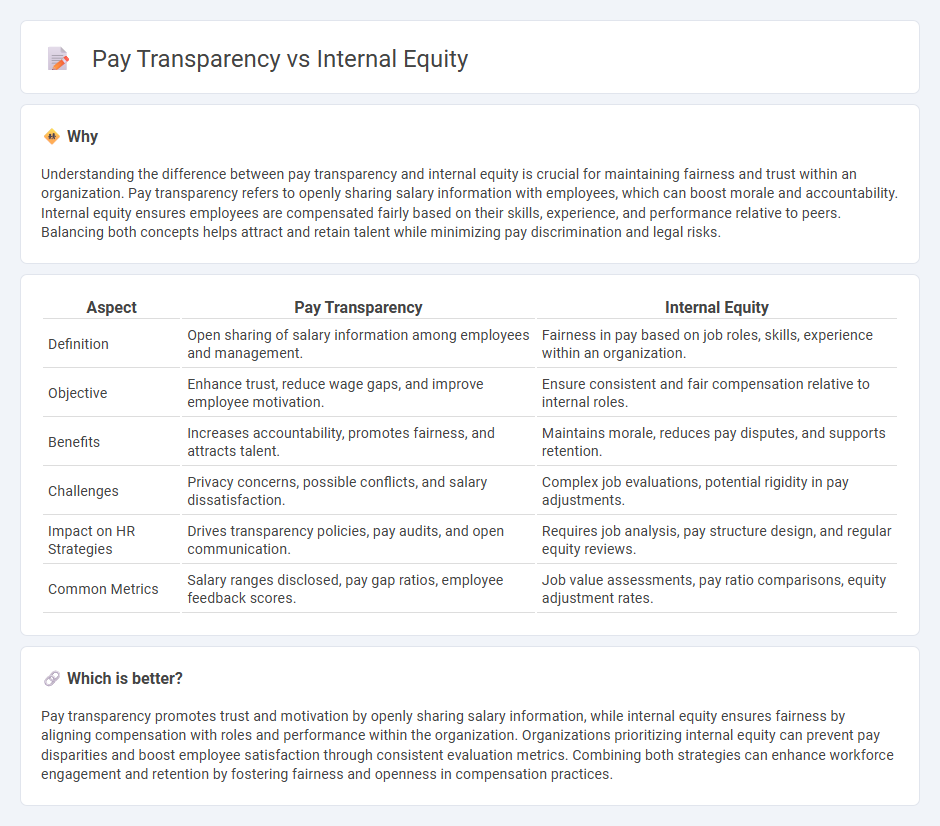
Pay transparency fosters trust by openly sharing salary information, while internal equity ensures fair compensation among employees with comparable roles and experience. Balancing both concepts promotes motivation and reduces wage disparities within organizations. Explore how integrating pay transparency and internal equity can enhance your company's compensation strategy.
Why it is important
Understanding the difference between pay transparency and internal equity is crucial for maintaining fairness and trust within an organization. Pay transparency refers to openly sharing salary information with employees, which can boost morale and accountability. Internal equity ensures employees are compensated fairly based on their skills, experience, and performance relative to peers. Balancing both concepts helps attract and retain talent while minimizing pay discrimination and legal risks.
Comparison Table
| Aspect | Pay Transparency | Internal Equity |
|---|---|---|
| Definition | Open sharing of salary information among employees and management. | Fairness in pay based on job roles, skills, experience within an organization. |
| Objective | Enhance trust, reduce wage gaps, and improve employee motivation. | Ensure consistent and fair compensation relative to internal roles. |
| Benefits | Increases accountability, promotes fairness, and attracts talent. | Maintains morale, reduces pay disputes, and supports retention. |
| Challenges | Privacy concerns, possible conflicts, and salary dissatisfaction. | Complex job evaluations, potential rigidity in pay adjustments. |
| Impact on HR Strategies | Drives transparency policies, pay audits, and open communication. | Requires job analysis, pay structure design, and regular equity reviews. |
| Common Metrics | Salary ranges disclosed, pay gap ratios, employee feedback scores. | Job value assessments, pay ratio comparisons, equity adjustment rates. |
Which is better?
Pay transparency promotes trust and motivation by openly sharing salary information, while internal equity ensures fairness by aligning compensation with roles and performance within the organization. Organizations prioritizing internal equity can prevent pay disparities and boost employee satisfaction through consistent evaluation metrics. Combining both strategies can enhance workforce engagement and retention by fostering fairness and openness in compensation practices.
Connection
Pay transparency fosters trust and accountability within organizations by openly sharing salary information, which directly supports internal equity by ensuring employees are compensated fairly relative to their roles and performance. Internal equity emphasizes consistent pay practices across employees with similar skills, experience, and responsibilities, reducing wage disparities and boosting morale. Companies practicing pay transparency more effectively identify and rectify inequities, promoting a fair workplace culture and enhancing employee retention.
Key Terms
Compensation Structure
Internal equity ensures fair compensation among employees based on job roles, skills, and experience within an organization, preventing pay disparities. Pay transparency promotes openness by sharing salary information, fostering trust and motivating consistent compensation structures aligned with market standards. Explore how balancing internal equity and pay transparency can optimize your compensation strategy.
Salary Benchmarking
Internal equity ensures employees are compensated fairly based on their skills and roles within the organization, preventing wage disparities and enhancing morale. Pay transparency involves openly sharing salary structures to foster trust and promote accountability in compensation practices. Explore how salary benchmarking aligns internal equity and pay transparency to optimize competitive and equitable pay strategies.
Communication Policy
Internal equity ensures fair compensation among employees based on roles, skills, and experience, fostering trust within the organization. Pay transparency involves openly sharing salary information, which can enhance accountability and reduce wage disparities but may also require careful handling to maintain morale. Explore how communication policies balance these concepts to create a cohesive and motivated workforce.
Source and External Links
What is Internal Equity and How to Address It - AIHR - Internal equity ensures employees are compensated fairly based on their skills, responsibilities, and experience, without discrimination based on personal characteristics, fostering fairness and motivation in the workplace.
Internal Equity | Human Resources | Baylor University - Internal equity is the practice of paying employees equitably for similar roles, responsibilities, and experience, with compensation decisions informed by internal comparisons and market data.
The importance of internal equity and how to address it - OnPay - Internal equity occurs when a company's compensation system treats all employees equally, paying them fairly based on job responsibilities and skills--not personal factors--which improves morale, trust, and loyalty.
 dowidth.com
dowidth.com